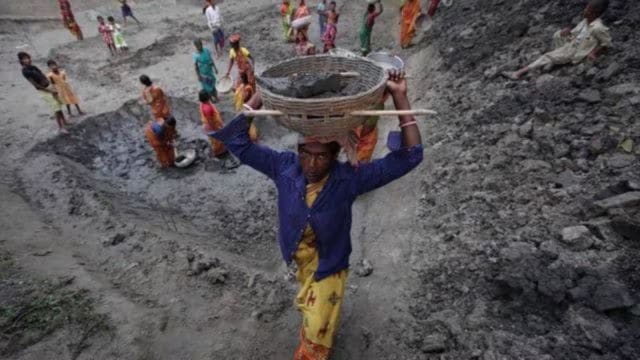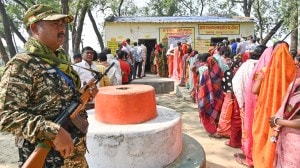The demand for work under the Mahatma Gandhi National Rural Employment Guarantee Scheme (MGNREGS) at the national level has steadily declined from its peak in 2020-21 during the Covid-19 pandemic, except in Maharashtra, Bihar, Himachal Pradesh, Arunachal Pradesh and Tripura. However, compared to pre-Covid levels, the demand is significantly higher, with 85 lakh more families availing of the rural job scheme in the 2024-25 fiscal year than in 2019-20.
According to the latest government data, 5.78 crore families worked under the scheme in the 2024-25 financial year across India (excluding West Bengal, where the scheme has been suspended since March 2022). This figure is 95.85 lakh lower than the peak of 6.74 crore families in 2020-21 (excluding West Bengal). However, the demand in 2024-25 is still higher than the pre-Covid level, as over 85 lakh more families worked at MGNREGS sites in the country (excluding West Bengal) in this period than in 2019-20.

While the MGNREGS demand has ebbed from its 2020-21 peak in most states, including Uttar Pradesh, Madhya Pradesh, Rajasthan, Odisha, Assam, Jharkhand, Chhattisgarh and Telangana, it is still recording a surge in five states — Maharashtra, Bihar, Himachal Pradesh, Arunachal Pradesh and Tripura.
Story continues below this ad
Maharashtra has experienced a significant rise in demand for MGNREGS work. In the 2024-25 financial year, 30 lakh families were engaged in MGNREGS employment in the state – nearly double the pre-Covid level of 15.37 lakh in 2019-20.
Further, even though there is a declining trend nationally since 2020-21, the demand in Maharashtra has steadily increased from 16.84 lakh in 2020-21 to 20.35 lakh in 2021-22, then to 21.20 lakh in 2022-23, and further to 24.46 lakh in 2023-24.
Bharatshet Gogawale, Minister for Employment Guarantee Scheme of Maharashtra, recently met Union Rural Development Minister Shivraj Singh Chouhan, seeking the release of funds for the state under the scheme.
Speaking to The Indian Express over the phone, Gogawale said that the rise in the number of families working under the MGNREGS in Maharashtra is due to the state government’s focus on individual works. In recent years, the state government has allowed the digging of wells on fields of small and marginal farmers and the construction of goat sheds and buffalo sheds under the scheme, he said. Besides, more and more tribal families are also joining the MGNREGS, he said. In addition to this, the state government provides a top-up over and above the 100-day legal guarantee of wage employment to the families willing to work under the rural job scheme, he said.
Story continues below this ad
In fact, Maharashtra now records a higher number of families working under the rural job scheme than some of its neighbours, including Karnataka, Telangana, and Chhattisgarh. In 2024-25, these three states saw the participation of 29 lakh, 26.6 lakh and 25.6 lakh families in the MGNREGS, respectively.
Along with Maharashtra, Bihar, Himachal Pradesh, Arunachal Pradesh, and Tripura have also reported an increase in MGNREGS demand during 2024-25 compared to the 2020-21 pandemic peak.
For instance, 7.18 lakh families in Himachal Pradesh availed MGNREGS benefits in 2024-25, up from 5.35 lakh in 2019-20, 6.36 lakh in 2020-21, 7 lakh in 2021-22, 6.46 lakh in 2022-23, and 6.74 lakh in 2023-24.
In Bihar, the demand for the MGNREGS hit its highest-ever level with 51.36 lakh families availing the scheme during 2024-25, which is higher compared to 33 lakh in 2019-20, 50.64 lakh in 2020-21, 47 lakh in 2021-22, 50 lakh in 2022-23, and 48 lakh in 2023-24.
Story continues below this ad
In addition, big states like Andhra Pradesh and Karnataka have consistently seen high MGNREGS participation levels. In the last five years, Andhra Pradesh saw the number of families availing the MGNREGS hovering between 45-47 lakh families annually, compared to 40.36 lakh in 2019-20. In Karnataka also, 29-30 lakh households availed of the MGNREGS in the last five years, as compared to 22 lakh in the 2019-20 pre-Covid period.
Meanwhile, the MGNREGS demand has ebbed from its 2020-21 peak in most states, including Uttar Pradesh, Madhya Pradesh, Rajasthan, Odisha, Assam, Jharkhand, Chhattisgarh and Telangana.
While Section 3 (1) of the Mahatma Gandhi National Rural Employment Guarantee Act (MGNREGA) provides for “not less than one hundred days” work per rural household in a financial year, it has become de facto upper limit as the NREGA software does not allow data entries for employment above 100 days to a household in a financial year unless specifically requested by the state/Union Territory.
However, in some cases, the government allows an additional 50 days of wage employment (beyond the stipulated 100 days). For instance, every Scheduled Tribe household in a forest area is entitled to get 150 days’ work under MGNREGS, provided that such families have no other private property except for the land rights granted under the Forest Right Act, 2016.
Story continues below this ad
Besides, the government, under Section 3(4) of the MGNREGA, can also provide an additional 50 days of unskilled manual work in a financial year, over and above the 100-day limit in rural areas where a drought or any natural calamity (as per the Ministry of Home Affairs) has been notified.
MGNREGS is the world’s largest social security programme that provides a legal guarantee of 100 days of wage employment in a financial year to every rural household whose adult members volunteer to do unskilled manual work, aimed at enhancing livelihood security and reducing rural poverty.









